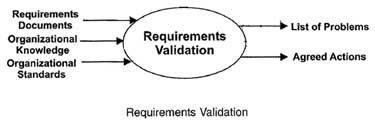
The development of software begins once the requirements document is ‘ready’. One of the objectives of this document is to check whether the delivered software system is acceptable. For this, it is necessary to ensure that the requirements specification contains no errors and that it specifies the user’s requirements correctly. Also, errors present in the SRS will adversely affect the cost if they are detected later in the development process or when the software is delivered to the user. Hence, it is desirable to detect errors in the requirements before the design and development of the software begins. To check all the issues related to requirements, requirements validation is performed.
In the validation phase, the work products produced as a consequence of requirements engineering are examined for consistency, omissions, and ambiguity. The basic objective is to ensure that the SRS reflects the actual requirements accurately and clearly. Other objectives of the requirements document are listed below.
Requirements validation is similar to requirements analysis as both processes review the gathered requirements. Requirements validation studies the ‘final draft’ of the requirements document while requirements analysis studies the ‘raw requirements’ from the system stakeholders (users). Requirements validation and requirements analysis can be summarized as follows:
Various inputs such as requirements document, organizational knowledge, and organizational standards are shown. The requirements document should be formulated and organized according to the standards of the organization. The organizational knowledge is used to estimate the realism of the requirements of the system. The organizational standards are specified standards followed by the organization according to which the system is to be developed.

The output of requirements validation is a list of problems and agreed actions of the problems. The lists of problems indicate the problems encountered in the” requirements document of the requirements validation process. The agreed actions is a list that displays the actions to be performed to resolve the problems depicted in the problem list.
We’ll be covering the following topics in this tutorial:
Requirements validation determines whether the requirements are substantial to design the system. The problems encountered during requirements validation are listed below.
To avoid the problems stated above, a requirements review is conducted, which consists of a review team that performs a systematic analysis of the requirements. The review team consists of software engineers, users, and other stakeholders who examine the specification to ensure that the problems associated with consistency, omissions, and errors are detected and corrected. In addition, the review team checks whether the work products produced during the requirements phase conform to the standards specified for the process, project, and the product.
At the review meeting, each participant goes over the requirements before the meeting starts and marks the items which are dubious or need clarification. Checklists are often used for identifying such items. Checklists ensure that no source of errors, whether major or minor, is overlooked by the reviewers. A ‘good’ checklist consists of the following.
The checklists ensure that the requirements reflect users’ needs and provide groundwork for design. Using the checklists, the participants specify the list of potential errors they have uncovered. Lastly, the requirements analyst either agrees to the presence of errors or states that no errors exist.
A number of other requirements validation techniques are used either individually or in conjunction with other techniques to check the entire system or parts of the system. The selection of the validation technique depends on the appropriateness and the size of the system to be developed. Some of these techniques are listed below.